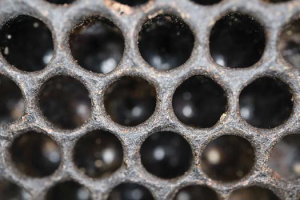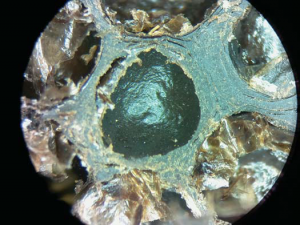Author: Bob Binnie
Whenever beekeepers report problems such as premature queen failure, sick brood, or excessive and repeated colony losses, one of the first questions they should ask themselves is: “How old is my comb and what has it been exposed to?”
Research has shown that old comb, especially old brood comb, contains significant levels of contaminants including pesticides, heavy metals, fungi, bacteria, and viruses. Any of these can be detrimental to a colony’s wellbeing and large amounts will produce all of the symptoms listed above and more.
Additionally, the cell diameter in old, heavy, black, brood comb can shrink from an accumulation of these materials along with fecal matter and cocoon silk left behind by each emerging bee. In a three-year field study at the University of Georgia, Jennifer Berry compared new comb to old, dark, heavy comb for brood rearing.¹ It was shown that, “On average, colonies with new comb produced a greater area of brood, a greater area of sealed brood, and higher weight of individual young bees.” Also, “Bees reared in old comb may weigh up to 19% less than bees reared in new comb” (Berry, 2001). The message here is clear: “Colonies full of old, dark, heavy comb will have smaller bees and fewer of them.”
“Comb rotation” is simply the removing of old comb and replacing it with either newer comb or new foundation to be drawn out, or allowing the colony to build their own new comb from scratch.
Until recently, comb rotation wasn’t considered very important, and in years past some beekeepers were actually proud of their old comb. They understood old, black combs to be strong and durable, and beekeepers especially valued them in extracting supers because they wouldn’t break apart during rapid uncapping and extracting.
Of course, our understanding has evolved since then. We now know that a colony of bees will eventually probe almost every square inch of a sizable piece of ground, and some of what they touch, collect and bring home can be very toxic. Nectar, pollen, and propolis frequently contain compounds that didn’t exist in the not-so-distant past, and because comb can absorb much of this, old comb should be considered a liability rather than an asset.
On a brighter note, honey consumers can take comfort in the fact that many of the toxins collected in nectar migrate to the comb because they are attracted to beeswax rather than honey. This is due to the lipophilic properties of wax, which means they tend to combine with or dissolve in lipids or fats rather than water. This is also why the comb in a beehive is often called “the liver of the colony.”
A few years ago, a second generation commercial beekeeper I know, who inherited much of his outfit from his father, was struggling to keep his bees alive and healthy. He had tried everything, or so he thought, to keep his bees in good condition, but nothing seemed to work. He suspected that the high percentage of very old comb in his hives might be part of the problem and sent samples off to a lab for a complete analysis.
A few days later, he got a call from one of the technicians at the lab who explained to him that they would be glad to take his money for an extensive analysis and report, but all he really needed to know was that nothing could survive in this comb.
He was dismayed at first and thought about quitting. However, rather than throw in the towel, he decided to undertake the laborious and expensive job of shaking all the bees from every colony onto new frames and foundation. Six months later, he reported having the best looking bees he had ever seen.
Another problem with old comb is the synergistic interactions that can occur between compounds previously absorbed and substances currently coming in. Because of the myriad of substances bees are exposed to today, the number of synergistic effects that can be generated is astronomical, and can be practically impossible to know.
When I began pollinating almonds in the early 1980s (before mites), I would often notice a setback in the overall condition of the bees immediately after a fungicide application. Although the change would sometimes be subtle, other beekeepers I knew noticed it, too, but we never considered it a major problem because it wasn’t extreme and the bees always seemed to bounce back.
Today’s world is very different. Because there are so many more chemicals our bees are exposed to and a colony’s comb is the ultimate sink for many of them, an exposure like that could result in interactions that are insidious and unforeseen.
An example of this occurred with a friend of mine some years ago when he came out of almond pollination in California with very sick colonies. The sickness was consistent throughout his entire outfit and was especially evident in the brood. It was a month or two after the bees returned home before they began to turn around, and it was midsummer before he felt like the problem had completely gone away.
This problem was especially puzzling because it developed while he was covering a contract with friends, and their bees were fine, even though they were in the same orchard and exposed to the same environment as his. They all moved their bees in and out of the orchard together and managed them in much the same way while they were there. Because he was a newer beekeeper and his equipment wasn’t very old, he ruled out the possibility that old, contaminated comb was the problem. No one could figure it out.
A year later, I recognized a possibility while attending a lecture aimed at beekeepers by Marion Ellis from the University of Nebraska where he spoke on the synergistic effects that occur between chemicals and substances bees are commonly exposed to. He shared a chart that included mite treatments (acaricides) routinely used by beekeepers, chemicals that bees are commonly exposed to in the field, and the levels of toxicity that occur when these substances interconnect.²
It was very interesting and enlightening to see all the possible combinations and the results of their interactions.
One of the things that caught my eye was that fluvalinate, the active ingredient in Apistan, which at one time was the varroa mite treatment of choice, was shown to have greatly increased toxicity when combined with many fungicides. Of course fungicides are widely used by almond growers and are routinely applied during the bloom period.
I knew my friend had been using this mite treatment for several years before the almond pollination in question, while the other beekeepers with him had been using an amitraz-based product which showed less toxic interactions with other compounds. Because fluvalinate is stable in beeswax (it persists in comb for years) and will build in concentration with repeated use, it seems plausible that exposure to fungicides in the almond orchard, combined with the residual chemical in his comb, produced a synergistic effect that caused his problem.
It’s helpful to understand that fungicides are simply a specific type of pesticide and many can be absorbed by comb and cause countless difficulties. Among these are issues with the production of bee bread, which leads to nutritional problems, and the hindrance of a honey bee’s ability to detoxify, which leaves a colony overly susceptible to an ensuing chemical exposure.²
Another fun fact is that the fungicide Prochloraz produces an almost 2000-fold increase in the toxicity of fluvalinate² (I wonder if it glows in the dark?). Although it is widely used in Europe, Australia, South America and Asia, American beekeepers can consider themselves lucky that Prochloraz is not currently being used here.
As a side note, I’ve noticed that fluvalinate-based products have been making a slight comeback as an alternative mite treatment to reduce the chance of resistance with other compounds. In my opinion, fluvalinate should not be used because of its persistence in beeswax and propensity for toxic interactions.
I personally experienced an instance of toxic comb about ten years ago when I made a deal with a northern beekeeper to install nucs in his equipment and let them sit in my southern yards in Georgia for a month before he picked them up.
I placed three frame nucs, produced from my bees, in his brood boxes along with enough of his drawn comb to complete the box. Within two weeks, I noticed brood issues developing in his boxes, even though the rest of our nucs looked great. I called him with a report and asked if he had any ideas. He asked me to give them a terramycin treatment, which I did twice, and also asked if he could leave them there for a few extra weeks. The brood problems did not go away, and when he finally picked them up, many were still struggling to expand into his comb, even though they had been on a nectar flow for several weeks. After some discussion, he admitted that he had been having trouble keeping his bees alive and was fairly sure it was because his comb had been exposed to years of multiple types and excessive amounts of chemical mite treatments. By the looks of his very black comb, I was inclined to accept his theory and winced at the idea of having handled his frames. He also admitted he was hoping to repopulate his equipment, make a crop, and sell out in late summer. This leads me to this straightforward and obvious advice: “Beware of purchasing nucs or colonies with old black comb.”
All of this begs the question, “How old is too old?” I don’t believe anyone can give an exact answer and suggest that it all depends on what the bees have been exposed to. Beekeepers that pollinate multiple crops each year and have a high degree of chemical exposure should consider rotating combs out more often than someone who is isolated from agriculture.
There are those that suggest all combs should be rotated out within three years for optimum results, while others advocate the replacement of twenty percent of your comb each year in order to achieve a complete turnover in five years. Still others believe that by not replacing all combs at the same time, the migration of substances from older combs to new ones permits a continuous low level contamination. Some, such as myself, approach it from a business perspective and try to understand where the point of diminishing returns begins when comparing costs to results. As for me, when all things are considered, I believe I am well served by replacing brood combs before they are ten or twelve years old. Please note: I no longer pollinate and this is only my opinion, and my conclusions are based on observations and experiences rather than a scientific study.
Beekeepers occasionally ask if using old black combs in extracting supers can influence the color and flavor of honey. Unless honey is filtered so completely that it removes all the particles and substances introduced by exposure to the comb and processing (i.e. uncapping, extracting, etc.), including those that are absorbed or microscopic, then both color and flavor will be influenced. The blacker the comb, the less subtle the results. We should also remember that, for better or for worse, these substances will be ingested when the honey is consumed.
Please also consider that changes will occur with color, flavor and aroma when cappings from old dark combs are separated from honey with a cappings melter. Although honey quality will always pay a price when wax is separated from honey by melting, the end result will inevitably be worse when old, black comb is involved.
All beekeepers should rotate out old comb as a part of their overall management strategy and this includes nontreatment and organic treatment beekeepers alike. Any beekeepers who think they are immune to the problems associated with old comb are kidding themselves. We can’t tell the bees where to go or what to bring home, and organic compounds can easily have nasty interactions, too. Even in what seems to be a non-exposure situation, combs will eventually become contaminated and overloaded with undesirable substances, and will need to be replaced.








